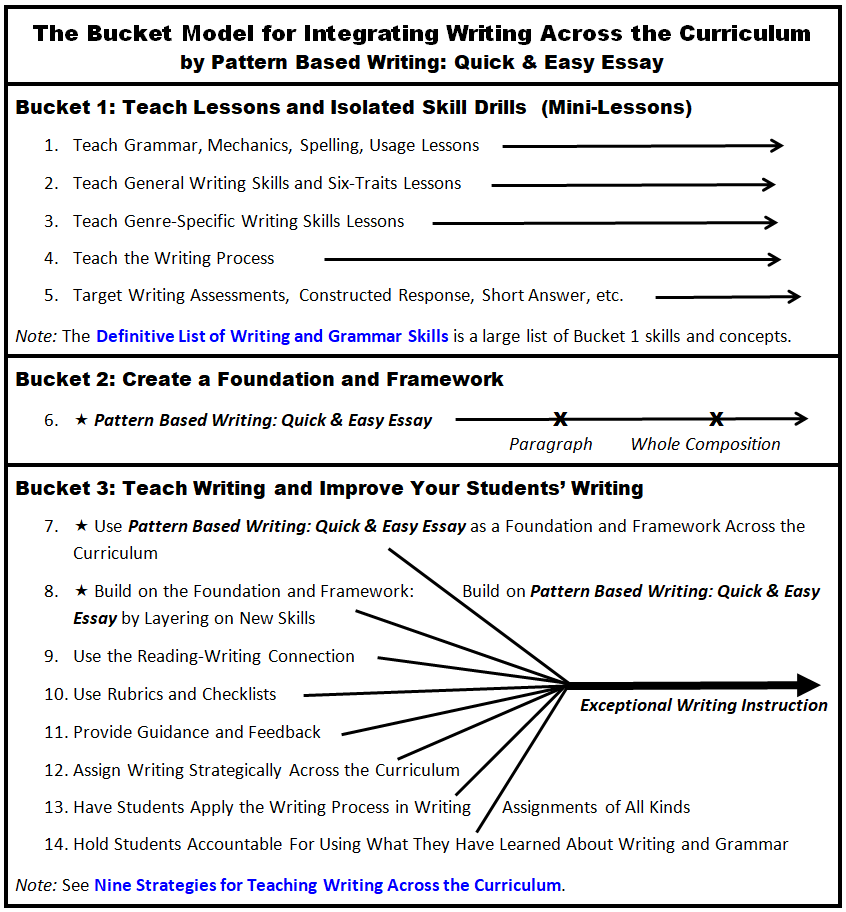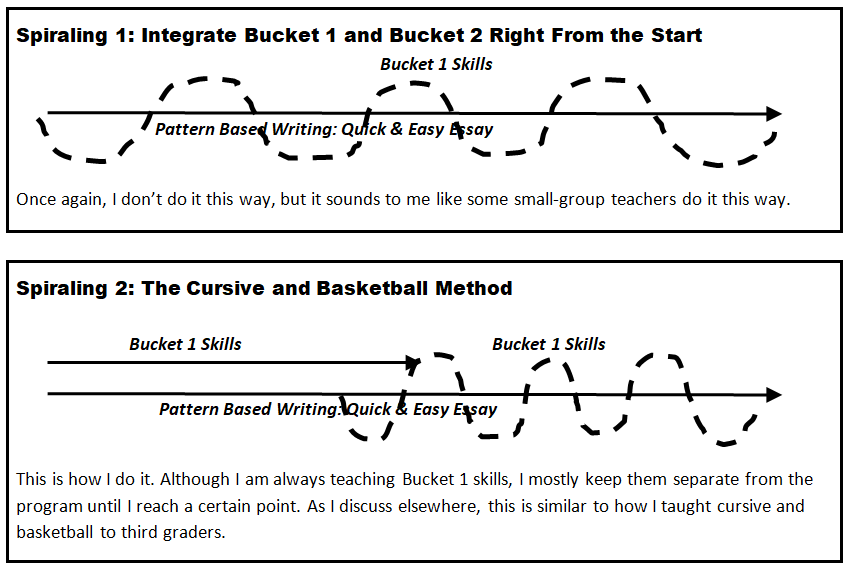Since all students write across the curriculum, all teachers teach writing across the curriculum. The question is this: Are they getting results? Are they improving their students’ writing?
To get results across the curriculum, teachers need to take charge of teaching writing across the curriculum. And to take charge of teaching writing across the curriculum, teachers need three things: 1) systems and routines, 2) materials and resources, and 3) knowledge of models.
What I present here is a big-picture model. Be sure to read my free eBook Nine Strategies for Teaching Writing Across the Curriculum for specifics on how to teach writing across the curriculum.
The Bucket Model: Straight Lines and Converging Lines
The heart of teaching writing across the curriculum is to tie everything together in a way that improves your students’ writing. After all, the goal is to improve our students’ writing!
But what are you supposed to tie together? To answer that question, be sure to check out the Definitive List of Writing and Grammar Skills. Furthermore, you can ask yourself one simple question: What is it that I teach my students about writing? That’s what you need to tie together.
The following Bucket Model puts things in perspective. When you are teaching writing, you are drawing from one of three buckets:
Bucket 1: Teach Lessons and Isolated Skill Drills (Mini-Lessons)
Bucket 2: Create a Foundation and Framework with Pattern Based Writing: Quick & Easy Essay
Bucket 3: Teach Writing and Improve Your Students’ Writing
In the graphic below, notice that the straight lines don’t connect. To teach writing effectively over time, teachers need to connect those straight lines in Bucket 3. In Bucket 3, various lines converge to create “Exceptional Writing Instruction.”
The Bucket Model Graphic
Let’s take a few minutes to examine the graphic. After that, I’ll explain what it all means!

Teaching Writing: Bucket 1, Bucket 2, and Bucket 3
Let’s now take a quick look at each of our three buckets.
Bucket 1: Teach Lessons and Isolated Skill Drills (Mini-Lessons)
To understand Bucket 1, you just need to understand two things:
2. Students learn to write by 1) prewriting, 2) writing, 3) rewriting, and 4) publishing. Although this can be done in Bucket 1, your time is better spent doing this in Bucket 3.
Think about a lesson on complex sentences or a lesson on revision. Although these are essential skills, these lessons have little value if they are not reinforced or required in the real world.
Notice in the graphic that the parallel lines head off into the future—never to connect. Put simply, if you teach a typical worksheet or curriculum lesson in each of those five Bucket-1 categories, they would not connect in any way. In real writing, they do connect.
Bucket 2: Create a Foundation and Framework: Pattern Based Writing: Quick & Easy Essay
As the Bucket model illustrates, Pattern Based Writing: Quick & Easy Essay is its own thing—its own category. Even though teachers can teach many parts of the program as isolated Bucket 1 lessons, the program is primarily a system and a methodology that ties everything together. Furthermore, it’s a system and methodology that teachers can build on and rely on in Bucket 3.
Pattern Based Writing: Quick & Easy Essay is the middle bucket. It creates a foundation and framework for connecting Bucket 1 and Bucket 3.
Bucket 3: Teach Writing and Improve Your Students’ Writing
Everything in the research on teaching writing and Writer’s Workshop theory says that teachers need to spend time in Bucket 3. Furthermore, the research says that if teachers stay in Bucket 1 and just keep turning pages, they may not create real writers. This is why teachers have historically become so disenchanted with their writing curriculums. Those curriculums are not what teachers believe them to be, and most of them are isolated skill drills.
Not only is writing “The Neglected R,” it’s also the most confusing R. I hope you can see and agree with this simple addition problem: Bucket 1 + Bucket 2 + Bucket 3 = Writing Success.
Integration: Bucket 1 and Bucket 2
The goal of Pattern Based Writing: Quick & Easy Essay is to create skilled and confident multi-paragraph writers quickly and easily and in a way that makes sense to students. I want my students cheering, “I finally get it! I can’t even read what I was writing before!”
However, experienced and novice teachers alike have asked me how to integrate Pattern Based Writing: Quick & Easy Essay with what they are already doing. Most of these teachers have a good idea of what they should do and want to do, but they want additional input and confirmation. When I follow up with teachers to see how things went, I always hear amazing stories. Teachers always find a way to make what they want to do work. Here are some examples of the types of questions that I may hear:
1. When should I teach strong verbs?
2. Can I stop at the paragraph stage and teach revision? Should I try to get a truly Perfect Paragraph before I move on?
3. What if my students are writing very simple sentences? Should I require sentence variety in the paragraphs? Can I require complex sentences?
4. What about juicy adjectives and word choice? Should I ban words?
5. What about grammar and mechanics? What should I do about grammar and mechanics?
Here is my answer:
1. Teachers need to teach Bucket 1 skills. That’s the reality of every classroom that I have ever seen.
2. Teachers can always (at all times) hold their students accountable for using the Bucket 1 skills that they have taught them. They can do this in any kind of writing and every kind of writing. It’s possible to hold students accountable and create student ownership at the same time.
3. Do what you feel is best. There is more than one way to get results. However, if it doesn’t produce results on the page or create engaged students, stop doing it. Keep in mind that everything is a tradeoff in time. Combining things can create synergy, or it can confuse students and bring the program to a standstill.
4. Spiral: Take breaks as needed, never force things, and don’t create a battle of wills. I always have a plethora of Bucket 1 skills that I want to teach my students, and I focus on those when my students need a break. Additionally, I may back up and practice paragraphs across the curriculum while I hold my students accountable for Bucket 1 skills.
How I Do Things: I Create A Basic Multi-Paragraph Foundation FAST
Personally, I want to create that multi-paragraph foundation and framework FAST so that teaching writing becomes easy. I find that students don’t TRULY understand paragraphs until they are introduced to multi-paragraph writing. A paragraph is a whole in itself, but it’s also a part of a whole composition. The word paragraph is both a noun and a verb. If students don’t understand this on a kinesthetic level, they don’t understand anything about paragraphs in real writing.
Although I teach Bucket 1 and Bucket 2 skills side by side, I don’t integrate the two Buckets as much as some teachers do, as I want to introduce my students to multi-paragraph writing first. I believe that the way I do it motivates students because I get them writing and I let them write and I make them reflect on their writing.
This helps students take ownership of their writing. I don’t want to be their personal editor. As a result, I find that many of the small problems that drive teachers crazy simply vanish. Why? Well, students have been learning the rules of mechanics and conventions for years. When teachers give their students a chance to write and own their writing (with a foundation and framework in place), they start to take pride and care about their writing. Small problems are easy to catch and fix when the desire is there.
Once again, many teachers do things differently. Many teachers like to maintain more control of the writing process, and they are good at doing so. Furthermore, it’s often appropriate and effective to do so in small group situations.
Hold Students Accountable in Stages: Don’t Overwhelm Them
Occasionally, I’ve had teachers ask me what they should hold their students accountable for while teaching the program. I’ve also heard amazing stories of how small-group teachers diligently hold students accountable and resolutely take students through the writing process. Although there are no rules, I will say this: When in doubt, hold your students accountable in stages. Don’t overwhelm them. Let them write! One of the two biggest mistakes in teaching writing is to not let your students write. (Note: The other biggest mistake is to let them write however they want to write.) Controlling everything is not what teaching writing is about. Here is one way to think about it: Start with Level 1.
Level 1: Spelling; punctuation; run-on sentences; mechanics; capitalization, etc.
Level 2: Strong verbs; verb agreement; pronoun agreement; advanced sentence structure; amazing word choice; dialogue; quotes; true editing; true revision; transitions; sensory details, etc.
Level 3: Story structure; story techniques; evidence; PPE (point, proof, explanation); reading-writing connection; common thought patterns (cause-effect, pro-con, etc.), etc.
Spiraling to Writing Success: Don’t Stay Stuck!
Each year, students learn a shockingly low amount of NEW information. (Note: I can’t find the statistics I once had.) Most everything we teach is a review of and builds on what students have already learned in prior years. In short, we add a small amount of NEW information to what students already KNEW. As we teach the NEW, we are forced to review and build on the KNEW. This is one form of spiraling. As a whole, school is built on spiraling because our brains can only handle so much NEW information at a time.
Once again, I encourage teachers to take charge of teaching writing. Use materials (including curriculums that spiral) strategically to improve your students ON THE PAGE writing. The reality of teaching writing is that teachers can see writing success or failure every single time their students pick up their pencils.
As teachers target what’s important, they must also spiral. Teachers can’t expect students to master concepts on the first try or even on schedule. Here are a few terms associated with spiraling:
» Spiraling: review, reteach, back up, hold accountable, reinforce, move on and return later, allow time to let it sink in, the need for multiple exposures, and circle back.
Keep in mind that every time you hold students accountable, you are reviewing and reinforcing, and therefore, spiraling. As you use Pattern Based Writing: Quick & Easy Essay (Bucket 2), you have two basic ways to spiral in Bucket 1 skills.





